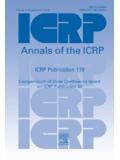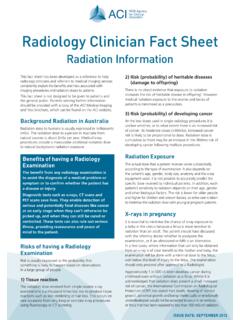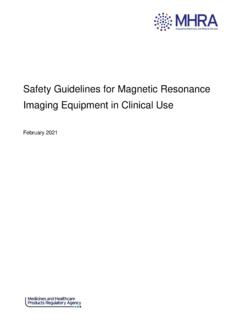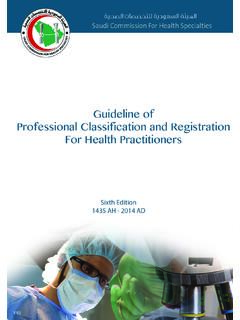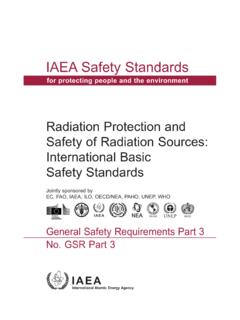Transcription of ICRP Publication 103 The 2007 Recommendations of the ...
1 This document is an extract from ICRP Publication 103 The 2007 Recommendations of the international commission on radiological Protection The full report is available for purchase and may be ordered online at: #description A shorter "users edition" is available at a lower cost and may be ordered here at: #description Annals of the ICRPPUBLICATION 103 The 2007 Recommendations of the InternationalCommission on radiological ProtectionEditorJ. VALENTINPUBLISHED FORThe international commission on radiological ProtectionbyAnnals of the ICRPP ublished on behalf of the international Commissionon radiological ProtectionAims and ScopeThe international commission on radiological Protection (ICRP) is the primary body in protection against ionisingradiation. ICRP is a registered charity and is thus an independent non-governmental organisation created by the1928 international Congress of Radiology to advance for the public benefit the science of radiological ICRP provides Recommendations and guidance on protection against the risks associated with ionishing ra-diation, from artificial sources widely used in medicine, general industry and nuclear enterprises, and from naturallyoccurring sources.
2 These reports and Recommendations are published four times each year on behalf of the ICRP asthe journalAnnals of the issue provides in-depth coverage of a specific subject to the journal receive each new report as soon as it appears so that they are kept up to date on the latestdevelopments in this important field. While many subscribers prefer to acquire a complete set of ICRP reports andrecommendations, single issues of the journal are also available separately for those individuals and organizationsneeding a single report covering their own field of interest. Please order through your bookseller, subscription agent,or direct from the is composed of a Main commission and five standing Committees on: radiation effects, doses from radiationexposure, protection in medicine, the application of ICRP Recommendations , and protection of the environment, allserved by a small Scientific Secretariat.
3 The Main commission consists of twelve members and a typically comprise 15 20 members. Biologists and medical doctors dominate the current membership;physicists are also well uses Working Parties to develop ideas and Task Groups to prepare its reports. A Task Group is usuallychaired by an ICRP Committee member and usually contains a majority of specialists from outside ICRP. Thus,ICRP is an independent international network of specialists in various fields of radiological protection. At any onetime, about one hundred eminent scientists are actively involved in the work of ICRP. The Task Groups are assignedthe responsibility for drafting documents on various subjects, which are reviewed and finally approved by the MainCommission. These documents are then published as theAnnals of the commission on radiological ProtectionChairman:Dr. Holm,Swedish Radiation Protection Authority (SSI), SE-171 16 Stockholm, SwedenVice-Chairman:Dr.
4 R. Cox,Health Protection Agency, Didcot, UKScientific Secretary:Dr. J. Valentin,ICRP, SE-171 16 Stockholm, Sweden; e-mail: of the Main commission of the Boice Jr,Rockville, MD, Clarke,Hampshire,UK (Emeritus)C. Cousins,Cambridge, Gonza lez,Vienna, AustriaJ. Lee,Seoul, KoreaB. Lindell,Stockholm, Sweden(Emeritus) Meinhold,Brookhaven,MD, USA(Emeritus) Mettler Jr.,Albuquerque,NM, USA(Emeritus)Z. Pan,Beijing, Pentreath,Cornwall, Preston,Research Triangle Park,NC, USAY. Sasaki,Tokyo, JapanN. Shandala,Moscow, Sinclair,Escondido, CA, USA(Emeritus)C. Streffer,Essen, GermanyA. Sugier,Fontenay-aux-Roses, FranceThis report was drafted by the following Task GroupFull Alexakhin,Obninsk, Russia(to 2005)C. Cousins,Cambridge, UK(from 2005) Gonza lez,Buenos Aires, ArgentinaH. Menzel,Geneva, Switzerland(2004-) Pentreath,Cornwall,UK(from 2003)N. Shandala,Moscow, Russia(from 2005)Corresponding membersP.
5 Burns,Yallambie, Winkler,Centurion, South Africa(z2003) Boice Jr.,Rockville, MDR. Cox,Chilton, Holm,Stockholm, Mettler Jr.,Albuquerque, NM(to 2005) Preston,Research Triangle Park,NC(from 2005)C. Streffer,Essen, GermanyJ. Cooper,Chilton, UKJ. Valentin,Stockholm, Sweden(Scientific Secretary) Clarke,Hampshire, UK(to 2005) Dicus,Poolesville, MD(z2005) Lee,Seoul, R. Korea(from 2005) Pan,Beijing, ChinaY. Sasaki,Tokyo, JapanA. Sugier,Paris, France(from 2003)The 2007 Recommendations ofthe international commission on RadiologicalProtectionICRP Publication 103 Approved by the commission in March 2007 Abstract These revised Recommendations for a System of radiological Protection formallyreplace the commission s previous, 1990, Recommendations ; and update, consolidate, anddevelop the additional guidance on the control of exposure from radiation sources issued , the present Recommendations update the radiation and tissue weighting factors in thequantities equivalent and effective dose and update the radiation detriment, based on the latestavailable scientific information of the biology and physics of radiation exposure.
6 Theymaintain the commission s three fundamental principles of radiological protection, namelyjustification, optimisation, and the application of dose limits, clarifying how they apply toradiation sources delivering exposure and to individuals receiving Recommendations evolve from the previous process-based protection approach usingpractices and interventions by moving to an approach based on the exposure situation. Theyrecognise planned, emergency, and existing exposure situations, and apply the fundamentalprinciples of justification and optimisation of protection to all of these situations. Theymaintain the commission s current individual dose limits for effective dose and equivalentdose from all regulated sources in planned exposure situations. They re-inforce the principle ofoptimisation of protection, which should be applicable in a similar way to all exposuresituations, subject to the following restrictions on individual doses and risks; dose and riskconstraints for planned exposure situations, and reference levels for emergency and existingexposure situations.
7 The Recommendations also include an approach for developing aframework to demonstrate radiological protection of the environment. 2007 ICRP. Published by Elsevier Ltd. All rights :Justification; Optimisation; Dose limits; Constraints; Reference LevelsICRP Publication 1031 EditorialWE COULD NOT HAVE DONE IT WITHOUT YOUR HELPThe new Recommendations of the international commission on radiological Pro-tection were adopted on 21 March 2007, Essen, Germany, after eight years of discus-sions, involving scientists, regulators, and users all around the commission is an advisory body that offers its Recommendations to regula-tory and advisory agencies, mainly by providing guidance on the fundamental prin-ciples on which appropriate radiological protection can be based. Since its inceptionin 1928, the commission has regularly issued Recommendations regarding protectionagainst the hazards of ionising radiation.
8 The first report in the current series,Pub-lication 1,contained the Recommendations adopted in 1958 (ICRP, 1959). The morerecent Recommendations have appeared asPublication 26(ICRP, 1977), andPubli-cation 60(ICRP, 1991b), and contain the Recommendations adopted in 1977 and1990, organisations and national authorities responsible for radiologicalprotection, as well as the users, have taken the Recommendations and principles is-sued by the commission as a key basis for their protective actions. As such, virtuallyall international standards and national regulations addressing radiological protec-tion are based on the commission s , most national regulations are based on the 1990 Recommendations inPublication 60. international standards, such as the international Basic Safety Stan-dards, various international labour conventions, and European directives on radio-logical protection are also based on these 26, the commission quantified the risks of stochastic effects of radi-ation and proposed a system of dose limitation with its three principles of justifica-tion, optimisation of protection, and individual dose limitation.
9 InPublication 60,the commission revised its Recommendations and extended its philosophy to a sys-tem of radiological protection while keeping the fundamental principles scientific data have been published sincePublication 60, and while the biolog-ical and physical assumptions and concepts remain robust, some updating is re-quired. The overall estimate of deterministic effects remain fundamentally thesame. The estimates of cancer risk attributable to radiation exposure have not chan-ged greatly in the past 17 years, whereas the estimated risk of heritable effects is cur-rently lower than before. The new data provide a firmer basis on which to modelrisks and assess Publication 1033 The 2007 Recommendations evolve from the previous process-based approach ofpractices and interventions to an approach based on the characteristics of radiationexposure situations. The system of radiological protection applies in principle to anysituation of radiation exposure.
10 Similar procedures are used for deciding on the ex-tent and level of protective actions, regardless of exposure situation. Specifically, theprinciples of justification and optimisation apply universally. ICRP is of the opinionthat by focusing more on optimisation, the implementation of protection for whathas until now been categorised as interventions could be view of the importance afforded to the commission s Recommendations and toensure that the new Recommendations adequately and appropriately address na-tional issues and concerns, the commission has initiated a much more open processthan that used for the development of the previous Recommendations . It should alsobe noted that the commission mentions, for the first time, the need to account forthe views and concerns of stakeholders when optimising commission has therefore solicited input from a broad spectrum of radiolog-ical protection stakeholders, ranging from government institutions and internationalorganisations to scientists and non-governmental organisations.
